Arts & Culture
About Andrew Cusack
 Writer, web designer, etc.; born in New York; educated in Argentina, Scotland, and South Africa; now based in London.
Writer, web designer, etc.; born in New York; educated in Argentina, Scotland, and South Africa; now based in London. read more
News
Blogs
Reviews & Periodicals
Arts & Design
World
France
Mitteleuropa
Knickerbockers
Argentina
The Levant
Africa
Cape of Good Hope
Netherlands
Scandinavia
Québec
India
Muscovy
Germany
Academica
New Yorkers: See New York!
Old-School Ads Employed for City’s Internal Tourism Campaign



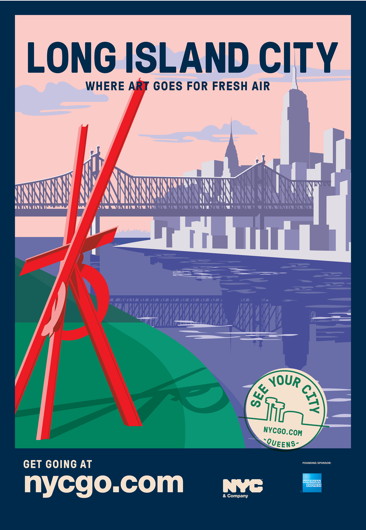
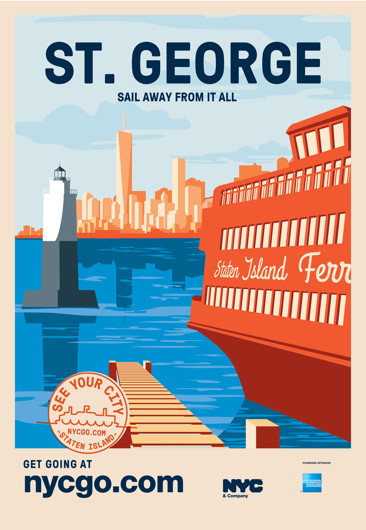
NYC & Company, the official tourism and marketing board of New York City, has cottoned on to the fact that in such a vast metropolis many parts of the city are virtually unknown to the natives of whichever particular borough.
They recently launched the ‘See Your City’ campaign encouraging New Yorkers to visit places perhaps less familiar to them within their own city. Part of the campaign involves the above series of posters for display in bus shelters.
The style evokes old-school travel posters of the 1920s & 30s, and NYC&Co commissioned one for each of the five boroughs.
Elsewhere: Adweek | New York Times | Untapped Cities | NYCgo
Russia’s Classical Future
Design chosen for St Petersburg’s new judicial quarter

While a vast and multifacted state, the Soviet Union was nonetheless one in which power was highly centralised, not just within one city — Moscow — but even within one complex of buildings, the Kremlin. For the past fourteen years, however, a St Petersburg boy — Vladimir Putin — has been the man at the helm of the ship of state, and while Moscow is still the top dog St Petersburg is increasingly stealing the limelight. The number of commercial bodies (several subsidiaries of Gazprom, for example) moving from Moscow to St Petersburg is growing, and even a few government departments and other entities have moved back to the old imperial capital.
Among these is the Constitutional Court of the Russian Federation, which transferred to the old Senate and Synod buildings in St Petersburg in 2008. The Supreme Court and Higher Arbitration Courts have yet to make the move, however, and a scheme by architect Maxim Atayants has been chosen as the winner of the design competition for the new judicial quarter on the banks of the Neva. (more…)
Ones to Watch (or Read)
In this commonwealth of knowledge, it is necessary to share out our sources of insight and wisdom. Here are just a few sites (“blogs”, even) that readers of this little corner of the web ought to take notes of.
Sancrucensis
http://sancrucensis.wordpress.com/
Fr Edmund Waldstein is a monk of Stift Heiligenkreuz near Vienna. He has been writing at Sancrucensis for some years now, but of course with so many distractions it often takes time to realise what is actually of value.
Fr Waldstein writes clearly and likes Charles de Koninck, so he can’t be all bad. His subject matter ranges from Saki to Žižek, and not long ago he weighed in on the Zmirak controversy.
His Amazon wish list is even larger — much, much larger — than my own, so perhaps you might think of shortening it through buying him a book.
Foolishly I neglected to visit Heiligenkreuz when I was in Vienna last year (though I did meet a chap there who wrote a history of the abbey), so I must make a pilgrimage next time I venture to the Kaiserstadt.
Opus Publicum
http://opuspublicum.wordpress.com/
This blog by Modestinus somewhat irritatingly uses the same WordPress theme as Sancrucensis, leading to occasional confusion in the Cusackian mind about who read what where. (UPDATE: It’s changed its design now.) Regardless, his ‘Weekly Reading’ updates feature selections that are very small-c catholic in taste (as well as big-C Catholic).
The names of Juan Donoso Cortes and Carl Schmitt are bandied about, and Modestinus is keen on elaborating upon Catholic Social Teaching, which seems to be getting a bit more attention all around these days.
Like Sancrucensis, Modestinus too has weighed in on our friend John Zmirak’s apostasy into liberalism. As a certain clerical personality on the outer reaches of London might put it: “Illiberal Catholicism? I’m into that!”
The Josias
http://thejosias.com/
This is not quite a blog, more of an occasionally updated resource. A multi-part series explores the American ‘Founders’ and the Aristotelian tradition, and be sure to check out ‘Have the Principles of the Right Been Discredited? Leo Strauss’s Rome and Ours’.
Worth reading also are ‘Theses against American Whig Catholicism, prompted by the atmosphere of 2012 and by the antiliberal writings of Deneen’, which De Koninck fans will enjoy.
For the Whole Christ
http://jcrao.freeshell.org/
Dr John C Rao posts a great deal of his work online at For the Whole Christ — skip to ‘Shorter pieces’ to find the more recent updates.
I am proudly in the Raovista camp, and this history professor and Catholic intellectual’s ongoing series of lectures in New York is enlivening, entertaining, and above all enlightening. Scandalously I have yet to attend the Summer Symposium in Gardone John organises every year under the auspices of the Roman Forum (it clashes with the part of the summer I am usually in the Lebanon). Some day, though, some day…
&c., &c., &c.
Of course there are the other usual places one ought to check often: The American Conservative and the much re-invigorated First Things. The Benedictus Trust (Patron: HMEH the P&GM) has been putting some of its lectures up on YouTube and Roger Scruton is headlining their Research Forum in London next year at the Linnean Society.
What have I been reading offline? Some Antal Szerb (Journey by Moonlight), some Tom Holland (In the Shadow of the Sword), and greatly enjoying some Régis Debray.
I recently forced the remnants of a dinner party I was hosting to listen to two and half pages of Voltaire-hatred from Maistre’s Soirées de Saint-Petersbourg (a sublime work!). The consistently interesting Dorchester Review featured an article on Joseph de Maistre not long ago, but it is impossible to obtain in London and I am too poor to subscribe. Perhaps I should give in and get a cheapo online-only subscription — this, after all, is what my iPad mini is for.
The Cusackian Academy
The other day I started drawing up a list. It started out as a list of people you should know, but then it took on its own life in the realms of my imagination as an assemblage of notables whether of thought, word, or deed. There is, of course, an Académie française, so why not an Académie cusackienne?
Membership of this list does not necessitate approval or sanction. It is more that these are the stars that speckle the Cusackian sky and in some way shine down providing some form or another of illumination. Some I like, others I admire, others still I disapprove of but at least find amusing.
As you might expect, it’s rather French-heavy, with a disproportionate dash of Magyars as well. Needless to say, very few of these illustrious academicians are still amongst the living. (more…)
Rowing Blazers Book Launch
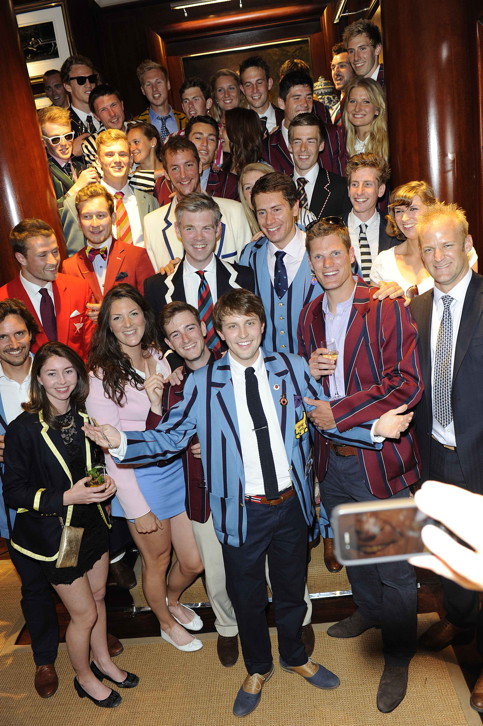
© Steve Finn Photography
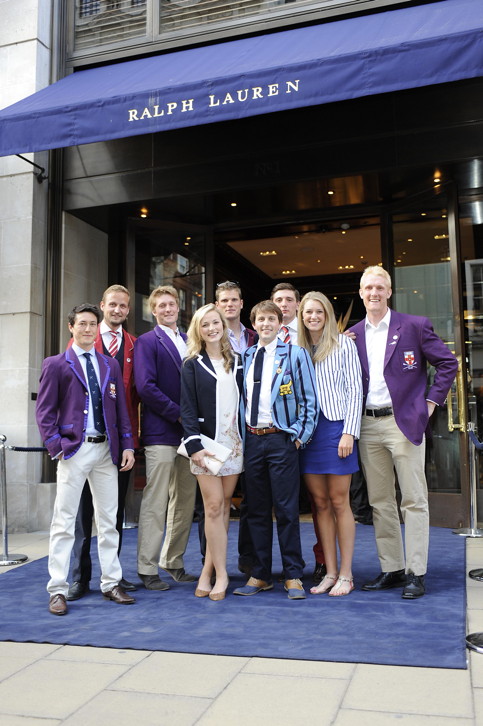
© Steve Finn Photography
by Jack Carlson, 2014
Thames and Hudson, 255 pages
£34.95 / ISBN: 978-0-500-51755-0
I am probably Jack Carlson’s worst friend — luckily for me, he is long-suffering. Many have been the mornings I have awakened in Oxford on some friend’s uncomfortable sofa (or worse: floor) and toddled haphazardly down to Jack’s regular coffee place for a restorative morning brew and inflicted upon the poor fellow my recounting of the previous night’s events in untrustworthy detail. Jack sits there, politely, smiling, waiting for the caffeine to take effect on me so that my tedious monologue can miraculously give way to the honoured pastime of friends: conversation.
It was during one of these chats — or it may have been over a winter evening pint in the King’s Arms; or a late summer afternoon pint in the Bear — that Jack revealed his book project: a coffee-table book on rowing blazers.
How tedious is that term ‘coffee table book’ which contemptuously mediocratises such beautiful, large-format, lusciously illustrated, and well-researched printed volumes into a mere additament of interior design. This format is probably my favourite kind of book, and I’m frightened to think how many pounds, dollars, rand, and euros I’ve invested in them over years.
But never mind. Rowing Blazers is now hot off the presses from Thames and Hudson here in Britain (and soon from Vendome Press across the Atlantic). And of course the perfect accompaniment to a good new book is a launch party to celebrate.
Jack assembled an impressive array of friends, rivals, and rowers to launch his latest book at Ralph Lauren in Bond Street last Thursday. There was an even more impressive array of stripes, colours, and piping on display amidst the bottomless glasses of Pimm’s and flutes of champagne generously refilled to no end by our hosts.
What about the book? It is beautifully presented, well-written, and includes a surprising variety of clubs from across the world. Rowing Blazers is a perfect gift for any rower — a must-have — so keep it in mind for birthdays and Christmases.
A number of the guests on Thursday flicked through the book’s pages to find their own clubs, rival clubs, friends photographed, and a fair amount of gossip was shared as well. Even when it came time to close up shop (literally, for once), the party continued at Bodo’s Schloss late into the wee hours. (more…)
Evolution of a Napoleonic Parliament
The Salle des états in the Palais du Louvre
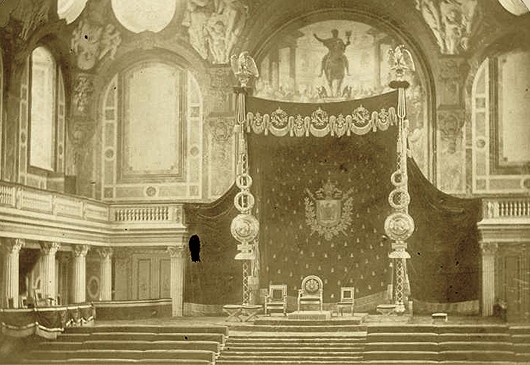
Among the numerous rituals of the ordinary visitor’s pilgrimage to Paris — trip up the Eiffel Tower, lunch at a tourist-trap café — braving the teeming hordes in the Louvre to view da Vinci’s ‘Mona Lisa’ ranks near the top. What very few of the camera-toting hordes realise is that they are shuffling through the room that once housed France’s parliament. The history of the Palais du Louvre is long, exceptional, and varied.
Originally built as a stern castle in the 1190s, the Louvre’s secure reputation led Louis IX to house the royal treasury there from the mid-thirteenth century. Charles V enlarged it in the fifteenth century to become a royal residence, while François Ier brought the grandeur of the Renaissance to the Louvre — as well as acquiring ‘La Gioconda’. In 1793, amidst the revolutionary tumult, part of the palace was opened to the public as the Musée du Louvre, but the Louvre has always housed a variety of institutions — the Ministry of Finance didn’t move out until 1983.
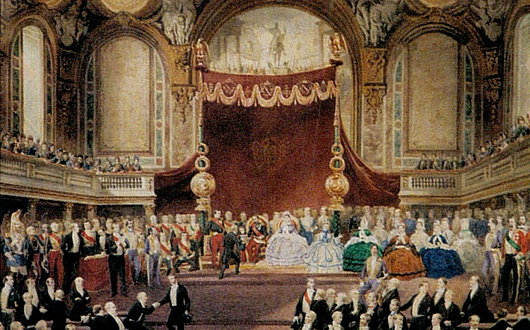
Napoleon III took as his official residence the Tuileries Palace which the Louvre was slowly enlarged towards over the centuries to incorporate. The Emperor needed a parliament chamber close at hand so he could easily address joint sittings of the Senate and the Corps législatif (as the lower house was called during the Second Empire) which opened the parliamentary year. By doing so at his residence, the Bonaparte emperor was following the example left by his kingly Bourbon predecessor Louis XVIII. (more…)
Italy inspired by Wall Street
Il Foglio is one of the most interesting newspapers in the world, and quite unique. It’s not a “great” newspaper like the FAZ or the Financial Times, with reporters in every major city around the globe, but this little “sheet” — usually just four or six pages — contains both a gazette of the day’s events alongside some of the best analysis and commentary in Italy. I’ve often thought that a London-based newspaper of a similar mould — not an everything-paper but instead simple, accurate, brief reporting combined with intelligent insight — could have an impact in Britain (and perhaps even America).
Its editor is the affable atheist, anti-abortion campaigner, and friend of Benedict XVI Giuliano Ferrara — an ex-Communist and former minister in Berlusconi’s first cabinet in the 90s — and it’s been said that Il Foglio comes closest to being the Italian proponent of a more Anglo-Saxon style of conservatism.
Today is Il Foglio’s eighteenth birthday, and looking back at the first edition, the design of the front page (above) obviously takes its inspiration from that of the Wall Street Journal. Things have changed since then, and while the Italian daily still clings proudly to its broadsheet format, the WSJ converted to what I call narrowsheet in 2006, as reported by us at the time.
In honour of this anniversary, Il Foglio has made available in PDF form its first ever edition (shorn of advertisements) which you can download here. (more…)
The Crowned Banner
The Emblem of the Scottish Parliament
Legislatures often have their own symbols. Often these are appropriated or stylised versions of national emblems. Stormont uses a flax plant. Some time ago Westminster adopted the Tudor portcullis which now represents the Parliament of the United Kingdom — in green for the Commons or in red for the Lords.
 In Scotland, however, the unicameral parliament has adopted a crowned banner as its distinctive insignia. (For previous posts on prominent emblems of modern Scottish design, see the Clootie Dumpling and the Daisy Wheel). The crown expresses authority — ultimately the sovereign power of the monarchy — while the corded banner hanging from a pommelled pole displays the Saltire, Scotland’s national flag. While early versions of the emblem were in blue, it is now standard that the symbol be depicted in purple, long a colour associated with Scotland through the national florae of heather and thistle. (more…)
In Scotland, however, the unicameral parliament has adopted a crowned banner as its distinctive insignia. (For previous posts on prominent emblems of modern Scottish design, see the Clootie Dumpling and the Daisy Wheel). The crown expresses authority — ultimately the sovereign power of the monarchy — while the corded banner hanging from a pommelled pole displays the Saltire, Scotland’s national flag. While early versions of the emblem were in blue, it is now standard that the symbol be depicted in purple, long a colour associated with Scotland through the national florae of heather and thistle. (more…)
End of the Line for Rizzoli Bookshop
Another New York bookshop bites the dust
In New York, good things are only allowed to last a little while: eventually they must all be destroyed. The latest to add to the pile is the Rizzolli bookshop on West 57th Street, which has received notice that the landlords intend to demolish the 109-year-old structure in which the bookshop is housed.
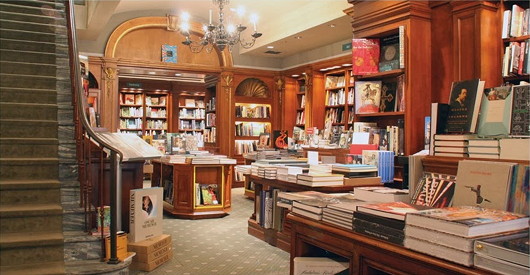
Rizzoli, publishers of some of the finest and most luxuriously printed books on the market, have not yet said whether they will be opening shop elsewhere.
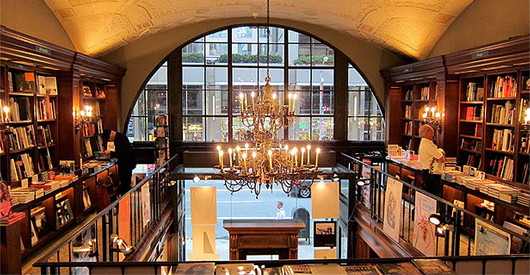
If so, it would be the second move for the shop, which opened in 1967 at 714 Fifth Avenue (below), just around the corner. A developer tried to tear that building down as well, but preservationists managed to have the façade, with its lalique glass, incorporated into the new tower. It’s now home to Henri Bendel.
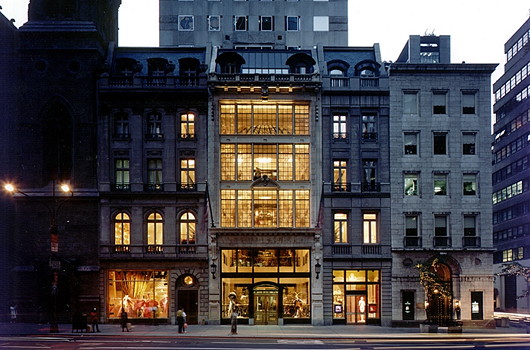
Other New York bookshops to close in recent years include the Librairie française, Coliseum Books, Gotham Book Mart, Urban Center Books, and further back more venerable institutions like Scribner’s and Brentano’s.
Top three photos: Mais Uma Pagina
A Bunny Rampant
The carto-heraldic creativity of MacDonald Gill
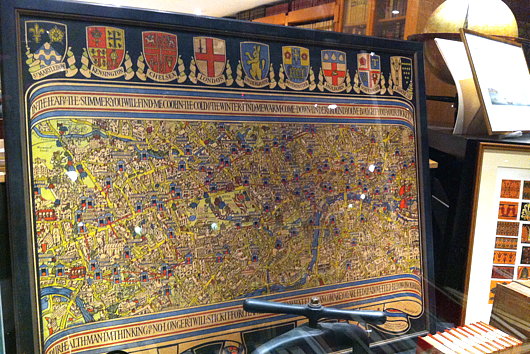
If anything, I am a lover of maps, and as a cartophile it’s a fine thing that I spend half my life in South Kensington. Here you will find two of the best antiquarian map merchants around: the Map House on Beauchamp Place and Robert Frew across from the Oratory and right next door to Orsini. Milling about in front of church after mass today I received a tip-off from a friend suggesting I have a look at the window of Robert Frew, as there was a London Underground map with coats of arms of mostly abolished boroughs.
“Sounds like the sort of thing MacDonald Gill would do,” I said, and sure enough upon investigating earlier tonight it is the work of that inventive designer (and brother of Eric Gill).
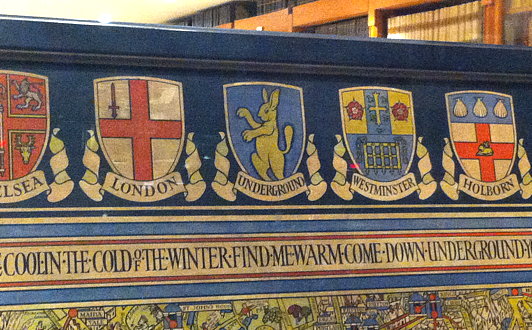
The most splendid and ridiculous aspect is that in the central place among the municipal heraldry was a putative coat of arms MacDonald Gill thought up for the Underground: a rabbit rampant. Indeed, given the twin characteristics of being speedy and digging the earth, the rabbit is a perfect animal avatar for the London Underground to adopt. Don’t go looking for this design anywhere in the rolls of Garter King of Arms, though: it’s merely the invention of the creative mind of master map-maker MacDonald Gill.
Two Flags Based on the French Tricolour
The French tricolour is one of the most influential flags in history, inspiring most prominently perhaps the Italian and Irish flags, but also dozens other, including the nationalist triband flags (like those of Germany, Russia, etc.). Indeed, the national flags of nearly sixty UN member states are based on these vertical or horizontal stripe combinations.
While long identified with revolution, republicanism, and nationalism, the French flag originally represented a combination of the blue and red of Paris — the colours of Saint Martin and Saint Denis — with the white of the French monarchy. Two (non-national) flags based directly on the French tricolour are those of the Acadians in North America and of Franschhoek in South Africa. (more…)
L’Osservatore Romano goes Hungarian
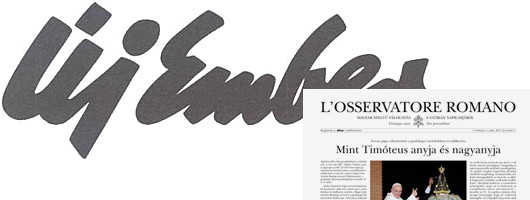
Magyarophiles will be pleased to learn that L’Osservatore Romano, the Vatican newspaper, will begin appearing in Hungarian. The new edition will appear every other week as a four-page insert into Új Ember, the Hungarian Catholic weekly founded in 1945. “We are a small editorial staff,” Balázs Rátkai, editor-in-chief of the weekly, told L’Osservatore.
“However, our intention is to probe and to make our readers think. The collaboration with the Vatican daily is of historic importance for the life of the weekly and of the entire local Church; it not only brings the Universal Church and the Pope closer to us; it will also enrich readers, and through them all of Hungarian society, with new thoughts, opinions and answers.”
Printed as a daily broadsheet in Italian, the Vatican newspaper also has weekly tabloid editions in French, Spanish, English, German, and Portuguese, as well as a monthly version in Polish.
Football at S. Maria Maggiore
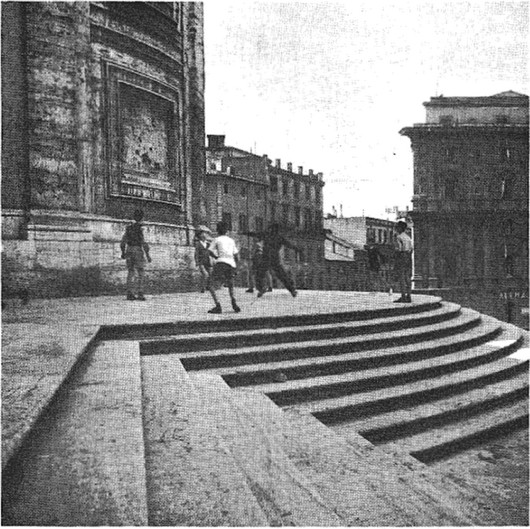
The enormous church of S. Maria Maggiore stands on one of Rome’s seven famous hills. Originally the site was very unkempt, as can be seen in an old fresco painting in the Vatican. Later, the slopes were smoothed and articulated with a flight of steps up to the apse of the basilica. The many tourists who are brought to the church on sight-seeing tours hardly notice the unique character of the surroundings. They simply check off one of the starred numbers in their guide-books and hasten on to the next one. But they do not experience the place in the way some boys I saw there a few years ago did. I imagine they were pupils from a nearby monastery school. They had a recess at eleven o’clock and employed the time playing a very special kind of ball game on the broad terrace at the top of the stairs. It was apparently a kind of football but they also utilised the wall in the game, as in squash — a curved wall, which they played against with great virtuousity. When the ball was out, it was most decidedly out, bouncing down all the steps and rolling several hundred feet further on with an eager boy rushing after it, in and out among motor cars and Vespas down near the great obelisk.
I do not claim that these Italian youngsters learned more about architecture than the tourists did. But quite unconsciously they experienced certain basic elements of architecture: the horizontal planes and the vertical walls above the slopes. And they learned to play on these elements. As I sat in the shade watching them, I sensed the whole three-dimensional composition as never before. At a quarter past eleven the boys dashed off, shouting and laughing. The great basilica stood once more in silent grandeur.
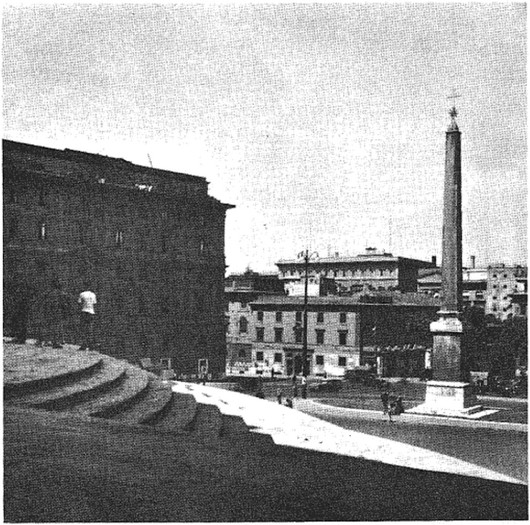
‘Bon Voyage’
Jean-Paul Rappeneau’s ‘Bon Voyage’ (2003) is one of those superb films that come around all too rarely. It manages to balance perfectly all the elements of drama, comedy, action, and romance, set in a convincing historical context.
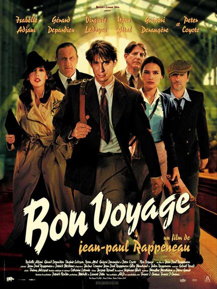
Bon Voyage
Jean-Paul Rappeneau
2003, France
1 hour 54 minutes
In 1940, Viviane Denvert (played by Isabelle Adjani) is a fickle, self-promoting film star who enlists her childhood friend, Frédéric Auger (Grégori Derangère), to extract herself from a compromising situation. As war creeps upon France, Auger finds himself behind bars for Viviane’s crime, but in the confusion of battle he manages to escape with the seasoned ne’erdowell Raoul (Yvan Attal). All of Paris is fleeing the German advance, and on the train to Bordeaux the two come across physics student Camille (Virginie Ledoyen) who helps them reach the western city by car when the train is stopped on the line.
In Bordeaux we come across government minister Jean-Étienne Beaufort, Viviane’s lover whom she uses to get Frédéric out of a sticky situation resulting from her own manipulation of him. Meanwhile, with all of Paris in Bordeaux, Viviane comes across another ex-paramour, Alex Winckler (Peter Coyote), keeping an unnatural interest in the affairs of the government, while the physics student Camille and her mentor Professor Kopolski are harbouring an important cargo they are determined must not fall into the hands of the Germans.
For fear of spoilers, that is all I will say about the plot, but it all comes packaged in a score by Gabriel Yared, better known for his scoring of ‘The English Patient’, ‘The Talented Mr. Ripley’, and Florian Henckel von Donnersmarck’s ‘Das Leben der Anderen’. The film was nominated for eight César awards in 2004 — best costumes, best director, best editing, best film, best original score, best sound editing, best supporting actor, and best writing — while it won three Césars that year for photography, best set design, and, for Grégori Derangère, best promising actor. (more…)
Zeitung für Deutschland
Given my total obsession with the Frankfurter Allgemeine Zeitung it will come as no surprise that my favourite advertising installation is the massive logotype for the world’s greatest newspaper which spans the railway tracks at the Frankfurter Hauptbahnhof.
In glorious Teutonic blackletter, it proclaims the newspaper’s ownership of the city to all comers:
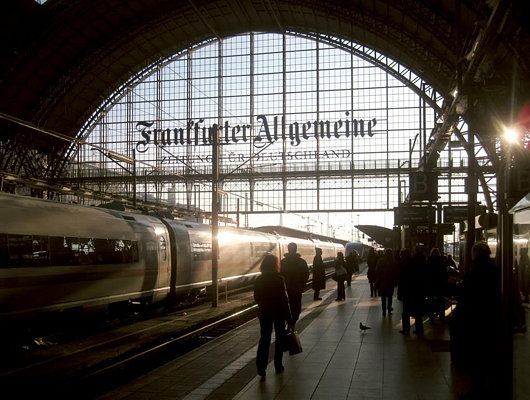
Photo: Erhard Bernstein
And while it looks great in daylight, as the evening descends it is illuminated in neon blue. Like the FAZ itself, old-fashioned and modern all in one.
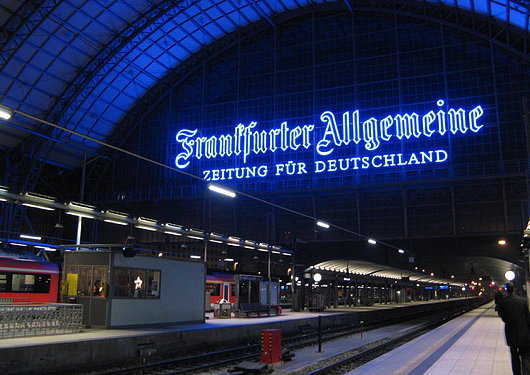
Photo: Otzberg
The Tragedy of Romeo and Rosaline
After an interlude of barely a month, the theatrical troupe of Fentiman returned to the Cathedral precincts with a presentation of Sharon Jennings’ play ‘The Tragedy of Romeo and Rosaline’. With the intriguing tagline of ‘Whatever happened to Romeo’s first love?’, the work explores the most famous love story of all time from the perspective of Rosaline, the niece of Capulet mentioned yet never seen in Shakespeare’s play.
A jaunty mix of ancient and modern, ‘Romeo and Rosaline’ includes some brilliant moments in its dialogue, peppered with occasional drops of the Bard’s own lingo and allusive humour ranging from the religious to the architectural. The action moves back and forth between just two locales: Rosaline’s own bedchamber, from which we view Verona, and Friar Lawrence’s cell, where we explore the meaning of transpired events.
Rachel Voldman as Nurse varies from the matronly to the almost sensuous. Philippa Tathum as Rosaline’s pushy mother exudes the confidence tempered by social-climbing of a minor landowner’s wife in colonial Kenya (Fair city of Verona meets the Happy Valley?). Althea Steven’s Rosaline is of course the crux of the action and capably carries off a teenage mix of coquetteishness and self-conscious over-introspection, finally consumed by the tragic epiphany that crowns the play’s final act. The theatregoer is lured in by fun and intrigue only to be hit suddenly with the full implications of has-been-ness.
In the end, ‘The Tragedy of Romeo and Rosaline’ is an exploration of isolation and ex-importance, displaying for us the furled banners of forgotten hopes and dreams, with all the faded, wasted glory of “You were the future, once.” Sharon Jennings has shined a well-aimed arclight on an unexplored realm and revealed the very essence of cathartic tragedy.
St Paul’s Gothicised
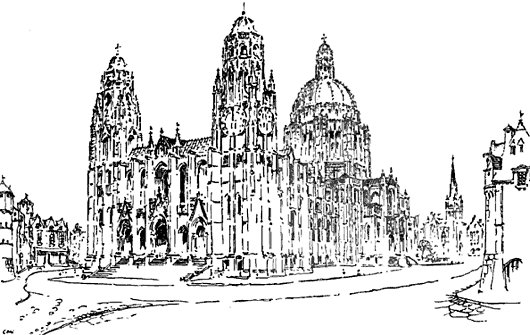
Victorian England went mad for the medieval, often neglecting or destroying buildings and structures of classical design along the way. Wren’s classical rood screen for Westminster Abbey is probably no great loss, but just imagine if his masterpiece, St Paul’s Cathedral, had been gothicised.
Just such was imagined by the architectural sketch artist C.A. Nicholson in two drawings he sent to the Architectural Record (albeit in the 1910s, not the Victorian era). Nicholson was inspired by an image printed in a previous issue of the Record showing the front of Peterborough Cathedral transformed into a classic design.
Of course before the Great Fire, Old St Paul’s was a Gothic cathedral.
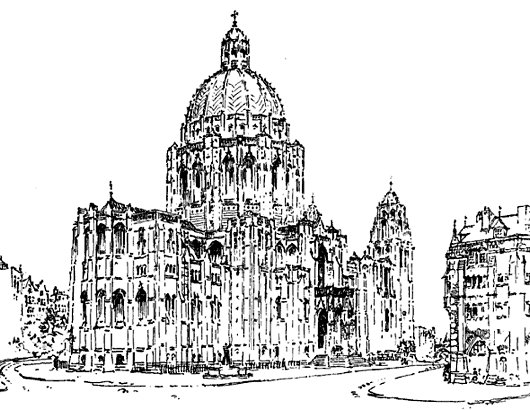
The Dome of the Custom House, Dublin
THE MOST RECENT series of the ITV detective drama “Foyle’s War”, though set in London, was filmed entirely in Dublin. (Ah, those Bord Scannán incentives!). I’ve noticed a phenomenon in which something set in England but filmed in Ireland suffers from English stereotype overcompensation. What this entails is unnecessarily sticking noticeably English ‘things’ (double-decker bus, red pillarbox) into the frame when, if filmed in England, the directors might otherwise be satisfied without these subconscious emblems reassuring the viewer that they are not in fact in the country the programme was actually filmed in.
So two characters meeting on a street of Georgian houses will have a red post box shoved into some arbitrary place on the street to remind us we’re in jolly old England. Despite this, any devotées of the Georgian style will recognise the Irishness of the houses because of the subtle yet noticeable difference between the Georgian styles of, say, London, Edinburgh, Bath, and Dublin.

Anyhow, not to reveal too much of the plot of this latest series, but Chief Superintendent Christopher Foyle is recruited into a post-war British intelligence gathering organisation. The exterior shots of the building used as this group’s headquarters is the Custom House on River Liffey in Dublin, only the show’s producers have digitally removed the building’s prominent dome, presumably in order to make it less distinctive and identifiable. (more…)
No. 6, Burlington Gardens
Sir James Pennethorne’s University of London
German university buildings are an (admittedly unusual) obsession of mine, and I’ve often thought that No. 6 Burlington Gardens is London’s closest answer to your typical nineteenth-century Teutonic academy’s Hauptgebäude. And the connection is appropriate enough, as No. 6 was built in 1867-1870 for the University of London in what had once been the back garden of Burlington House (which at the same time became home to the Royal Academy of Arts). Despite the building’s Germanic form, the architect Sir James Pennethorne decorated the structure in Italianate detail, providing the University with a lecture theatre, examination halls, and a head office. Pennethorne died just a year after drafting this design, and his fellow architects described it as his “most complete and most successful design”.
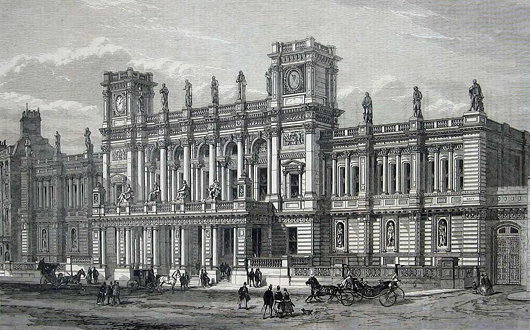
The University of London was founded as a federal entity in 1836 to grant degrees to the students of the secularist, free-thinking University College and its rival, the Anglican royalist King’s College. It now is composed of eighteen colleges, ten institutes, and a number of other ‘central bodies’, with over 135,000 students.
Since its founding, the University had been dependent upon the government’s purse for funding, as well as for housing. Accomodation was provided in Somerset House, then Marlborough House, before evacuating to temporary quarters in Burlington House and elsewhere. It was not until the 1860s that Parliament approved the appropriate grant for a purpose-built home for the University to be erected in the rear garden of Burlington House. (more…)
IHT, RIP
New York Times Kills Off the International Herald-Tribune
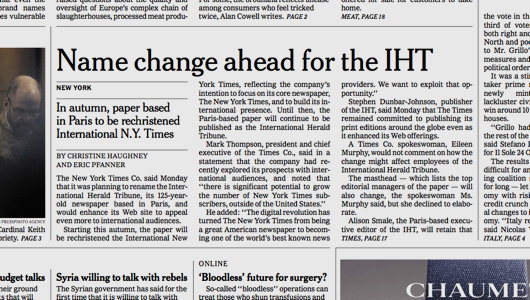
The New York Times Company, owners of the Paris-based International Herald-Tribune, announced recently that they are going to kill off the 126-year-old newspaper. I had predicted back in 2009 that this was precisely what would happen because of the aimless direction the IHT had taken since the New York Times became the sole owners of the title in 2002, after a long period of joint ownership with the Washington Post. The IHT will be merged into the worldwide operations of the Times this autumn and be rebranded as the International New York Times
 Hendrik Hertzberg of the New Yorker bids adieu to the Trib, remembering the first time he left the U.S. in 1960. Crain’s New York Business provides a brief overview of NYTCo’s decision. Margaret Sullivan, the Times’s ‘Public Editor’, reduces any appreciation for the Herald-Tribune as mere emotive romantic nostalgia. Nikki Usher mourns the IHT’s tendency to broaden the Times’s typically American editorial lens. Meanwhile, Ken Layne of The Awl is a bit frank about the decision to drop the Herald-Tribune for The International New York Times: “That’s an incredibly shitty name that makes no sense at all!”
Hendrik Hertzberg of the New Yorker bids adieu to the Trib, remembering the first time he left the U.S. in 1960. Crain’s New York Business provides a brief overview of NYTCo’s decision. Margaret Sullivan, the Times’s ‘Public Editor’, reduces any appreciation for the Herald-Tribune as mere emotive romantic nostalgia. Nikki Usher mourns the IHT’s tendency to broaden the Times’s typically American editorial lens. Meanwhile, Ken Layne of The Awl is a bit frank about the decision to drop the Herald-Tribune for The International New York Times: “That’s an incredibly shitty name that makes no sense at all!”
Search
Instagram: @andcusack
Click here for my Instagram photos.Most Recent Posts
- Amsterdam November 26, 2024
- Silver Jubilee November 21, 2024
- Articles of Note: 11 November 2024 November 11, 2024
- Why do you read? November 5, 2024
- India November 4, 2024
Most Recent Comments
- on The Catholic Apostolic Church, Edinburgh
- on Articles of Note: 11 November 2024
- on Articles of Note: 11 November 2024
- on Why do you read?
- on Why do you read?
- on University Nicknames in South Africa
- on The Situation at St Andrews
- on An Aldermanian Skyscraper
- on Equality
- on Rough Notes of Kinderhook
Book Wishlist
Monthly Archives
Categories


